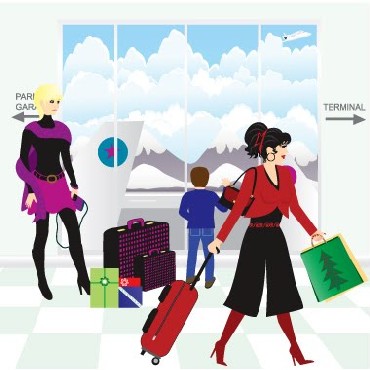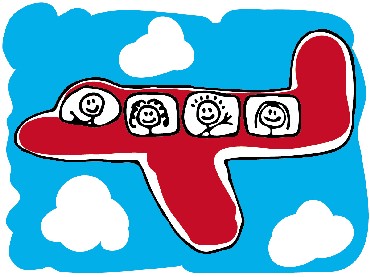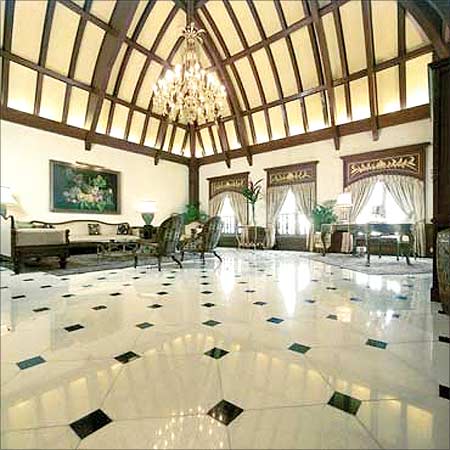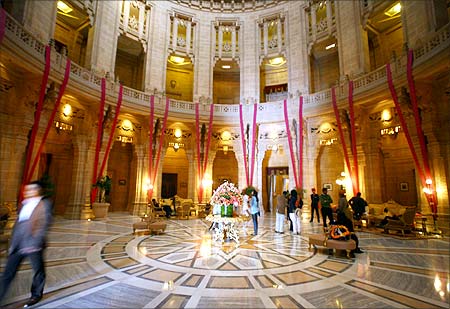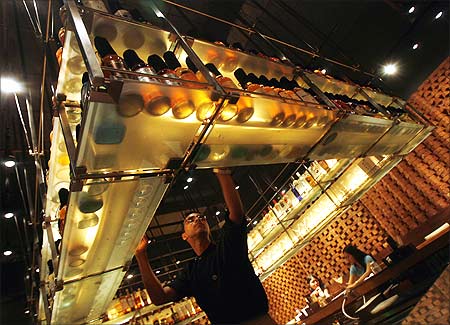 | « Back to article | Print this article |
2010: Hospitality sector bids adieu to hard times
India's hospitality sector checked into 2010 with hopes of revival after suffering heavily from the 2008-09 economic downturn and the year did not disappoint.

An over 10 per cent increase in tourist arrivals and rising hotel occupancies consigned the memories of the economic downturn and the 26/11 Mumbai terror attacks to the far corner of the industry's mind.
In fact, the re-opening of the heritage wing of Mumbai's iconic five-star hotel Taj Mahal Palace on August 15 reiterated that the industry has moved on, overcoming challenges and ready to embrace a rosy future.
Click NEXT to read further. . .
2010: Hospitality sector bids adieu to hard times
The year saw revival of many hotel projects that were stalled during the two years of uncertainty.

While domestic hotel companies started expanding their presence by opening new properties, international brands were seen making an aggressive move to establish themselves in India.
For hoteliers in the capital, who readied an estimated 45,000 new rooms in Delhi for the 12-day Commonwealth Games in October, the event was a let down as it did not bring many international visitors -- mainly owing to the negative publicity on financial irregularities by the Games Organising Committee and the rush job to create infrastructure.
Click NEXT to read further. . .
2010: Hospitality sector bids adieu to hard times
The industry also saw some unusual business when Reliance Industries Ltd picked up 14.80 stake in EIH Ltd, that operates Oberoi and Trident brands of hotels and resorts for over Rs 1,000 crore (Rs 10 billion).

The move was seen as an effort to ward off a potential hostile bid for EIH by rival ITC. Nonetheless, for others like Hotel Leela Venture, Fortune Park Hotels, Peppermint Hotels, Sarovar Hotels & Resorts, Oberoi Hotels and Resorts and Royal Orchid it was business as usual, announcing plans to expand their presence.
"The hospitality sector's performance has been good during the year. Foreign tourist arrival increased as compared to the previous year. The overall occupancy during season time started touching 70-80 per cent levels.
Click NEXT to read further. . .
2010: Hospitality sector bids adieu to hard times
Also uptick was seen in the average room rates," Elara Capital, analyst, Himani Singh told PTI.

The nationwide occupancy, which began its upward curve in the second half of 2009 continued into 2010 after plummeting in 2008-09 fiscal.
However, hotels gave precedence to occupancy over room tariff, resulting in a rate correction.
As per estimates of consultancy firm, HVS Hospitality services, during the year the four star and above categories saw rate correction of about 15 per cent, whereas three-star hotels witnessed a correction of 5.1 per cent.
"There will be further rate corrections across hotel categories owing to competition from leading international and domestic brands entering the market as well as the availability of quality options in the mid-market and budget category," HVS report on hotels in India, trends and opportunities said.
Click NEXT to read further. . .
2010: Hospitality sector bids adieu to hard time
The signs of recovery seen during the year was partly driven by strong demand coming from domestic travellers.

At the same time, foreign tourist arrivals in India saw an increase as compared to the last year.
As per the estimates of Ministry of Tourism, total foreign tourist arrival during January-November 2010 was 49.29 lakh (4.92 million), up 10.4 per cent as compared to 44.63 lakh (4.46 million) during January-November 2009.
Even foreign exchange earnings for the 11 months ended November 2010 stood $12.64 billion with a growth of 27.8 per cent as compared to FEE of $9.89 billion during January -November 2009, according to the ministry's website.
During the year, the government also made conscious efforts to revive the sector through a slew of policy changes.
Click NEXT to read further. . .
2010: Hospitality sector bids adieu to hard times
In the Budget, tax sops were announced for the sector by giving investment-linked tax deduction for new hotels -- two- star and above -- commencing operations from April 2010.

The Reserve Bank of India also said loans for hotel construction will not be classified as commercial real estate.
It also relaxed external commercial borrowing norms lifting a previous cap of $100 million under the automatic route and allowing hospitality firms to borrow more than that.
Buoyed by the reviving market and favourable policy environment, many firms chose to announce their new projects and future plans.
Click NEXT to read further. . .
2010: Hospitality sector bids adieu to hard times
While ITC revealed its plan to open 60 new hotels in the next 3-4 years, Fortune Park Hotels, ITC's wholly-owned subsidiary, said that it had plans to add 25 new property by 2011-end.

Hotel Leela Venture said it will invest Rs 3,000 crore (Rs 30 billion) by 2014 to operationalise five more luxury hotels in India.
Similarly, not wanting to be left behind, companies such as Peppermint Hotels, Sarovar Hotels & Resorts, Oberoi Hotels and Resorts and Royal Orchid also announced massive investment in property expansion.
Companies like Lalit Suri Hospitality Group, which runs the Lalit chain of hotels announced its decision to foray into the mid-market segment with a new brand called 'The Lalit Traveller'.
Click NEXT to read further. . .
2010: Hospitality sector bids adieu to hard times
On the contrary, Apeejay Surrendra Park Hotels inaugurated its luxury lake cruiser in Vembanad Lake (Kerala), marking its formal entry into the leisure segment.

Besides homegrown brands expanding in India, several international brands made a beeline for the country.
For instance, Microsoft founder Bill Gates- promoted luxury hotel group Four Seasons said it has plans to open four new properties in India within the next five years.
Global hospitality chain Carlson announced plans to open its luxury brand Regent here with the opening of a hotel in Gurgaon in 2013.
Similarly the InterContinental Hotels Group launched its first Holiday Inn brand in India with a 225-room property in Mumbai.
Click NEXT to read further. . .
2010: Hospitality sector bids adieu to hard times
Even Thai hospitality group Amari expressed its desire to open seven hotels across the country by 2018.

Other big names that joined the bandwagon include Singapore-based hospitality firm Alila Hotels and Resorts, US-based Choice Hotels International, JW Marriott and Accor.
While international brands planned their way to India, Indian companies were planning the other way round.
Among those that announced international expansion plans include Oberoi Hotels and Resorts which announced a new project in Mauritius.
The company also has plans to enter Thailand in the next three years.
Similarly, Tata Group's hospitality arm Indian Hotels Company, which owns and runs the Taj brand, announced its entry into the South African market with the opening of its Rs 50-crore (Rs 500-million) luxury property in Cape Town.
Click NEXT to read further. . .
2010: Hospitality sector bids adieu to hard times
Another firm, Royal Orchid Hotels is also planning to start a new project in Tanzania (Africa) from next year onwards.
 For EIH, it was a memorable year when The Oberoi Vanyavilas, Ranthambore, was ranked the best hotel in the world according to a readers' poll by 'Travel+Leisure' magazine in July.
For EIH, it was a memorable year when The Oberoi Vanyavilas, Ranthambore, was ranked the best hotel in the world according to a readers' poll by 'Travel+Leisure' magazine in July. The company had also completed acquisition of 49 per cent stake in its joint venture partner, Amex Investment in EIH Holdings, for about Rs 200 crore (Rs 2 billion) during the year.
Click NEXT to read further. . .
2010: Hospitality sector bids adieu to hard times
Looking ahead, according to HVS estimates, around 89,449 branded or quality hotel rooms are likely to come up in the next five years.

Delhi-NCR alone is expected to witness maximum hotel development with about 20,000 rooms are under development.
The hospitality sector is buzzing again with activity and is set to greet the New Year with a confident and pleasant smile.
